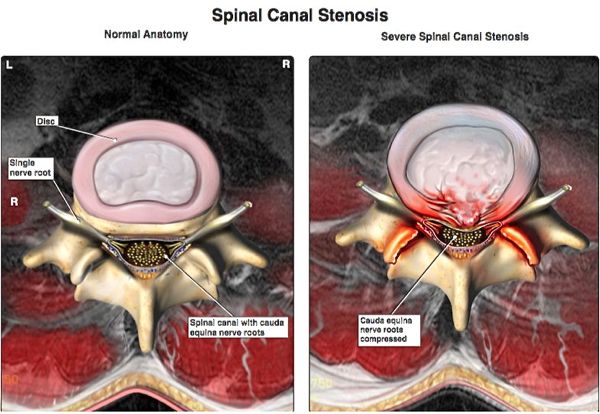What does Cauda Equina mean?
The nerves extending down your spinal canal into your lower ("lumbar") back, below the termination of the spinal cord are referred to as the cauda equina ("horses tail") spinal nerves. This is because the nerves, no longer in the protection and shield of the spinal cord, flare out in the same way as does a horse's tail. Cauda equina means horse tail, in Latin.
What is Cauda Equina Syndrome?
This uncommon disorder is a surgical emergency that impacts the cauda equina, which is a bundle of nerve roots located at the lumbar section of the spinal cord. These nerve roots are responsible for sending and receiving messages between the brain, lower extremities and pelvic organs. When these nerve roots are compressed, sensation and movement is cut off. Cauda Equina Syndrome is a medical emergency requiring surgery. If not treated immediately, paralysis, bladder and bowel control and sexual sensation can all be damaged. Even patients that seem immediate treatment can suffer permanent damage.
What are the symptoms of Cauda Equina Syndrome?
A devastating constellation of symptoms including pain radiating down one or both legs; weakness of the legs; lack of feeling in the genital area; and bladder/bowel disturbance (no urge to urinate/defecate, or incontinence)
You do not necessarily have all of these symptoms to be suffering from Cauda Equina Syndrome.
What is the primary cause of Cauda Equina Syndrome?
A central herniated disc compressing the cauda equina nerve roots in the spinal canal. The nerves at this level control bladder/bowel control, as well as sensation and motor activity beneath the waist. A tumor, infection, fracture, or narrowing of the spinal canal may also cause Cauda Equina Syndrome.
How is Cauda Equina Syndrome diagnosed?
Typically, Cauda Equina Syndrome requires a clinically based diagnosis (i.e. based on the patient's symptoms), confirmed by MRI imagining studies which show the compression of the cauda equina nerve roots.
Is Cauda Equina Syndrome a medical emergency? Why?
CES is a definite spinal emergency. Once a patient experiences the above symptoms it is a rush against time to remove the source of the trouble, i.e. the central herniated disc. This requires surgery. The longer you wait to decompress these nerves associated with Cauda Equina Syndrome, the greater the likelihood of permanent difficulties with walking, urination, defecation and sexual activity.
Medical illustration of compression of cauda equina nerve roots (right) vs normal anatomy (left):

Video Presentation by Nick Todd, Consultant Neurosurgeon & Spinal Surgeon.
Recorded at the Royal Society of Medicine, 1 Wimpole Street, London
To view this cauda equina syndrome video presentation click the arrow below.
Below are resources for those interested in the causes and treatment of Cauda Equina Syndrome, and organizations to help people cope with this condition.
Cauda Equina Group on Facebook (must have Facebook account)
Citations:
"Medicolegal Consequences of Cauda Equina Syndrome: An Overview", John Kostuik, MD, Neurosurg Focus 16 (6):39-41, 2004
"Predictors of outcome in Cauda Equina Syndrome", J.G. Kennedy, MD, et.al. Eur. Spine J (1999) 8:317-322
"Discogenic Compression of the Cauda Equina: A Surgical Emergency". T.A.R. Downing, et.al MD Aust. N.Z. Surg. 1993, 63, 927-934
"Causes of nerve injury. Terminology. Compression nerve injury", Ch. 17, "Nerve Injuries and their Repair, a Critical Appraisal", Sir Sydney Synderland, MD, Churchill Livingstone, 1991
